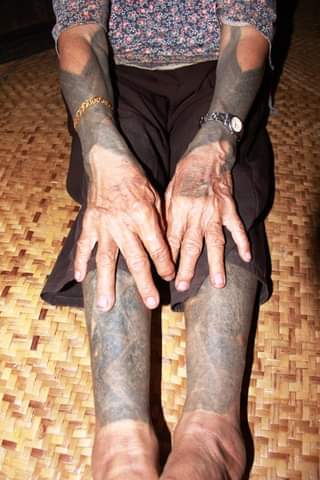Betik Tattoo
The Kelabit are a Sarawakian Dayak ethnic group. They are one of Sarawak's smallest ethnic groups, which had a population of about 6,600 in 2013. Over the past 20 years, a large number have moved to cities, leaving only 1,200 to remain in their isolated birthplace in the Bario highlands.
Like all traditional cultural practices around the world, getting a tattoo is strongly connected to both physical strength and the spiritual realm for the people of Borneo. In this article, we will be discussing the Betik tattoo on Kelabit women.
The Kelabit (betik) tattoos are distinguished by their geometric designs, which frequently resemble zigzags. From the wrist to the forearm, their arms are covered in tattoos. The tattoo on their legs extends from the ankle's base all the way up to the middle of the thigh, if not higher. Every betik has a unique name. Betik lawa on the outside of the calf, betik lulud on the shin, betik beti on the calf, or betik tido on the hands are a few examples.
The Betik can be finished on both sides of the legs in two weeks to a month. From one leg component to the other, it was completed stage by stage. The woman will undergo testing with the Beti Tutun before having her entire leg tattooed (trial betik). This is done to see if the person can handle the pain that will be caused.
The tattoos were applied with needle points, and the black or dark bluish green colour was created by combining soot with water and, occasionally, a small amount of resin.
Tattooing is solely done on women, and only women work as tattoo artists. Every longhouse has a different tattoo artist (which is a hereditary position). The tattoo artist will receive a hefty payment for the tattooing services; frequently, it is a very expensive bead. A lady would give herself as a worker to work in the tattoo artist's fields in exchange for her tattoo if she wanted one but lacked the means to pay for it.

(Tattoos on Kelabit women - Image taken from Facebook, Credit Central Kelapang - Kelabit Highland Sarawak BORNEO)
References
Ini Adalah Sebab Mengapa Wanita Orang Ulu Bertatu Pada Zaman Dulu. I Love Borneo. (2021). Retrieved from https://www.iloveborneo.my/ini-adalah-sebab-mengapa-wanita-orang-ulu-bertatu-pada-zaman-dulu/.
Kelabit people - Wikipedia. En.wikipedia.org. (2022). Retrieved 27 August 2022, from https://en.wikipedia.org/wiki/Kelabit_people.
Why Tattoo?. Dayak Impressions. (2012). Retrieved from https://dayakimpressions.wordpress.com/2012/12/31/why-tattoo/.